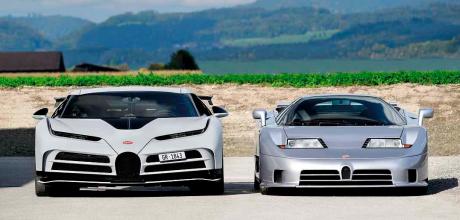2023 Bugatti Centodieci
Bugatti celebrated its 110th anniversary in 2019 by announcing the 1600bhp Centodieci. Now it’s a reality, Stephen Archer has his warp-speed perceptions altered.
Photography Tim Scott
MAD WORLD THE ULTIMATE BUGATTI
BUGATTI CENTODIECI Exclusive drive of the ultimate hypercar
World exclusive test of the 1600bhp, 305mph, EB110-inspired Centodieci
The Bugatti’s throttle is flattened at 30km/h and within a second I feel on the edge of greying out. A few more seconds and I am hanging by the seatbelts, trying to collect my thoughts – and body parts. What kind of ungodly performance has been unleashed here? There was a time not so long ago when a car with 100bhp per tonne was considered adequately powerful. So how should we look at a car with 1600bhp? That is not far short of what the 27-litre Spitfire Merlin engine delivered. But this thing has to stay on the ground, which it can cover at the rate of a mile every 12 seconds.
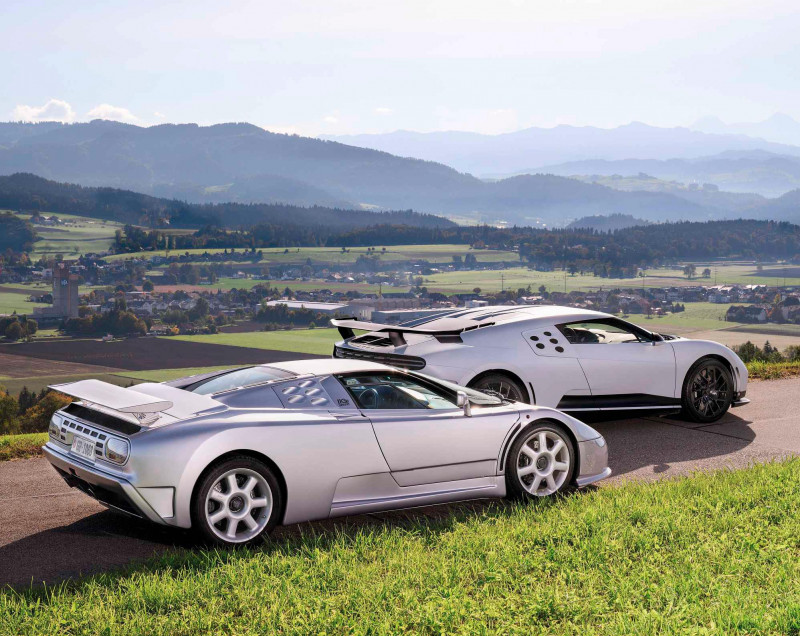
This, then, is the latest manifestation of Bugatti’s long pursuit of unsurpassable automotive design. Sure, in the heyday of Ettore Bugatti, things were different, more delicate, more race-bred. More personal to the founder, if you will. But the Centodieci (it translates as ‘110’) marks the latest chapter in the latest rebirth, and the timing is apposite: in 2021, ownership of Bugatti passed to a joint venture between Porsche and Croation electric hypercar maker Rimac, 55% in favour of Rimac. The marque had reached its 110th anniversary in 2019, when the Centodieci was first shown, and all ten examples were built during 2022.
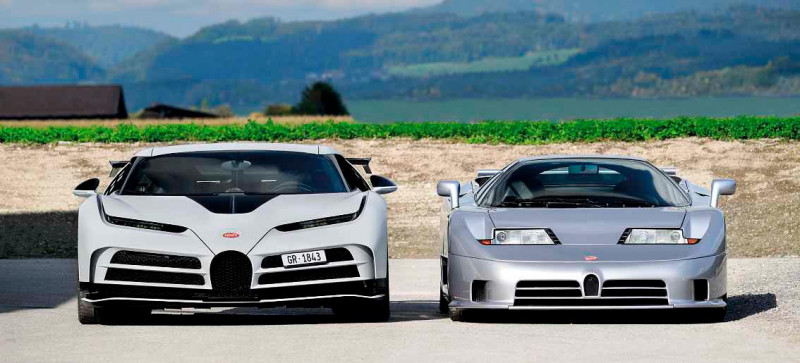
The days of Ferdinand Piëch’s stipulation that the Bugatti Veyron would surpass 1000 (metric) horsepower already seem long ago. Another car marked Bugatti’s rebirth in 1991: the EB110 was revealed on the occasion of Ettore’s 110th birthday, its blue touch paper lit by the Italian entrepreneur Romano Artioli. The 212mph, four-wheel-drive EB110 was among that first wave of hypercars: XJ220, F1, F40 and so on. Autocar said it made ‘more sense’ than the larger Jaguar XJ220, being ‘sensationally dynamic, but useable every day’.
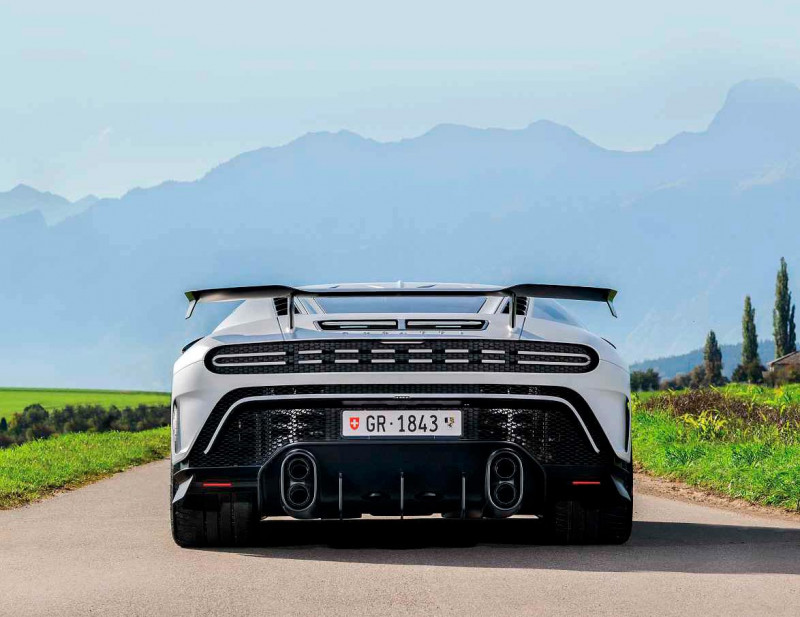
Less ‘portly’ than the Diablo VT and with a power-to-weight ratio of 353bhp per tonne, it was beaten in that regard only by a superlight Caterham (472!) and the XJ220 (372).
Autocar again: ‘60mph flashes by in 4.5sec, and the car hasn’t really got into its stride. Nor has it genuinely relaxed by the time 100mph registers 5.1sec later. If you must boast of one figure, make it the 30-70mph time of 3.3sec.’
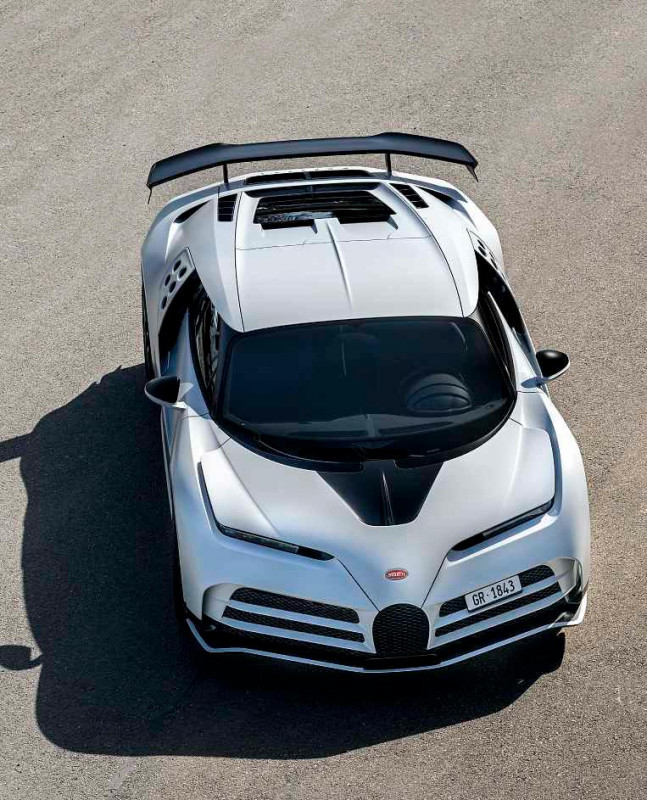
The lighter, more powerful SuperSport you see here emerged in May 1992. Drive it today and the 3.5-litre quad-turbo V12’s friendly flexibility when tootling around town is still mighty impressive, but squeeze the right pedal and a ‘bridge to engine room’ early-generation turbo behaviour is revealed. Coals on, the turbos can be heard spooling-up and motion is gently increased until a symphony of whistles accompanies rather more exciting progress. The cabin is more M5 than hypercar, with period-style satin leather, controls to match, and a gearbox that is easy but not 21st Century perfectly clicky. It’s not so comfy if you are over 6ft tall but this 215mph supercar is a compact package and light to handle, and though it is 30 years old it’s certainly no fossil – and it looks sensational. Today it is a highly collectable $2m-plus mobile work of art that will fit inside more garages than most of its ilk.
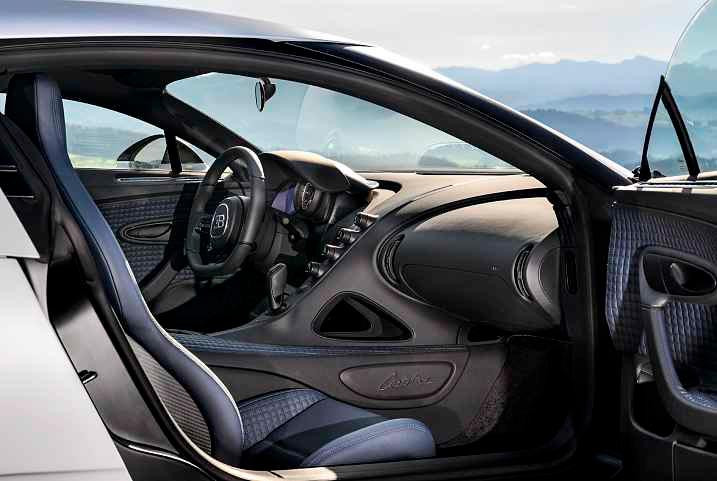
Despite widespread appreciation and even a foray to Le Mans, Bugatti struggled in its new incarnation and in 1998 the marque came under the mighty wings of VW and the even mightier ambition of Ferdinand Piëch. He oversaw the creation of the 2005 Veyron that, in true Bugatti style, made the world sit up and take notice thanks to its pioneering packaging of an 8.0-litre W16 engine, novel styling and enough technical genius to fill a book. The project purportedly lost €4.5m per car but Piëch was playing the long game, putting engineering achievement and its halo effect ahead of profit.
The even more spectacular Chiron broke cover in 2016 and took over as hypercar benchmark – until the Centodieci appeared on the streets in 2022. And to make one thing clear, if you want to play Top Trumps, this is the car to have in your pack: €8m each, all sold, and the final one of ten just delivered.
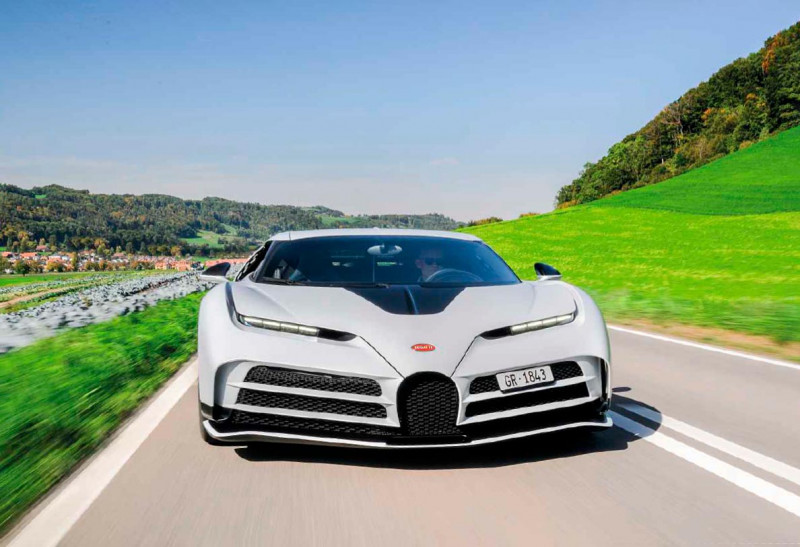
Though it’s based on the Chiron, the Centodieci’s body has been reinterpreted as an homage to the novel design of the EB110. ‘Focused’ would be one way to describe it. Bugatti has taken the Chiron and made it, well, madder, even more extraordinary. It is lighter by 40kg and, so long as we’re happy with the Euro-standard metric measurement, fully 100bhp more powerful than the Chiron, which has ‘only’ 1500bhp. It’s sobering to consider that this output is more than 400bhp greater than the Veyron Super Sport managed.
Having been subjected to organ-grinding g forces in the passenger seat, it is with more than usual trepidation that I approach the driver’s side. Especially as most of the driving will be on Swiss public roads. The cabin is more like a refined space capsule than that of a car, its swooping central arch a structural component that gives it a pilot and co-pilot feel. The controls are exquisitely functional, designed with minimalism and simplicity. There is none of the Pagani bling; indeed, nowhere on the car is there anything twinkly and bright and distracting. Everything you touch reeks of quality and blank-cheque R&D.
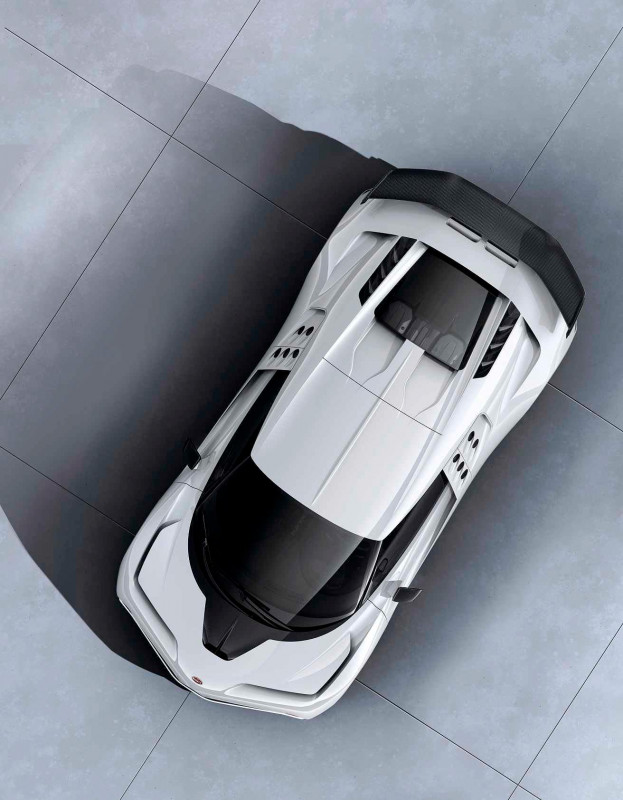
Bugatti doesn’t do compromise. Tons of torque is no longer a novelty in the world of electric and hybrid drivetrains, as Bugatti’s new owners will know. But this petrol-powered hypercar has 1179lb ft, nearly three times that of America’s favourite 5.0-litre load-lugger, the Ford F150. Its 8.0-litre W16 has four turbos working in tandem, the two-stage system employing two up to 3800rpm, making for instant throttle response at any engine speed.
All that motive force demands massive air consumption and two of the enormous exhaust pipes are directed groundwards to create a downforce-enhancing blown diffuser. Packaging all this and managing resultant heat extraction is an achievement in itself, but don’t expect a close look: the owner is not intended to open the bonnet. In fact, it can’t be opened. Power to the four wheels goes through a seven-speed automated dual-clutch transmission.
Some might suggest that the Centodieci is more demure than the Chiron but when it lifts its skirts the truth will out. The Centodieci is restricted to ‘only 260mph’; unrestricted, it is good for ‘more than 305mph’. The restriction is not simply because covering a mile every dozen seconds is a bad idea, but because at that speed even the special tyres are getting rather hot – and the 100-litre fuel tank will be drained in seven minutes, during which time the car will have covered more than 35 miles. This is truly other-worldly performance.
So it’s hard to benchmark a car like this. Reaching 62km/h in 2.4sec is almost too much to comprehend. Michelin’s bespoke tyres have been specially designed for the unique wheels. The huge, 420mm carbon brakes are as strong as you could want, thanks to a total of 28 brake pistons in 3D-printed titanium calipers – the design could not actually be machined… And the chassis has to be very clever to manage such crazy physics. While the driver has a choice of four settings, from town use to racetrack, at all times electronics are performing continual adaptation, with damping, ride height, aerodynamics, steering and power managed automatically to keep the beast poised and safe. The feel and weight of every control cannot be faulted. It goes without saying that grip in every direction is virtually unshakable and it can pull 1.6 lateral g. The Centodieci is not a narrow car and, at just under two tonnes, it’s no flyweight either, yet it never feels anything other than under strict control. There is no hint of an edge in store.
With all these brains in action it is perhaps no surprise that the car feels utterly benign, but such technology can mean that the car’s soul is eradicated, too. Here the genius of Bugatti is at its zenith. At every moment you are aware that this is no ordinary hypercar. From the start button on the steering wheel to the tiny but ever-so-precise gear selector, communication is ample. This feels like a driver’s car.
The real challenge comes in working out where to drive it. Not so much at 500km/h, but simply to let it get into its stride. Cars made to do certain things are happiest when that is asked of them. Back in the day, Bugatti excelled in Grand Prix races that took place on longer tracks than today’s. The Centodieci would be fabulous on some of those old circuits, such as the original Spa, Pescara or, of course, Le Mans. A car of this calibre has to be viewed through very different eyes. To drive it to the edge of its performance envelope is to demand a recalibration of so many things by the driver.
And it’s not only about speed over the ground. The car can do things that no other road user can comprehend. You need a new sense of awareness; you may drive it as an auto and get out feeling relaxed or you can take control of the paddles and experience more performance than most mortals would be able to imagine. It exists on a different plane.
The antecedents of this ultimate Bugatti derive from Italy (Ettore), France (where he lived and built the cars) and Germany (the engineering heft behind it). Take the best of those three and it perhaps comes as no surprise that the Centodieci is so remarkable. It’s possibly the best-looking Bugatti since the original EB110, too; pure yet dramatic.
Aside from Aston Martin’s Valkyrie, which is arguably a street racing car, the Centodieci may be looked back upon as the highest (and craziest) watermark for the internal combustion engine. But so much more than the Aston, its understated quality, purity and ambition mark it out as a car that few could build. Its combination of user-friendliness with violent ferocity is nothing less than an extraordinary – and fitting – achievement.
THANKS TO The Pearl Collection.
TECHNICAL DATA 2023 Bugatti Centodieci
- Engine 7993cc W16, DOHC per bank, four turbochargers, electronic fuel injection and engine management
- Max Power 1578bhp @ 7000rpm
- Max Torque 1179lb ft @ 2000-6000rpm
- Transmission Seven-speed dual-clutch automated, four-wheel drive, rear LSD
- Steering Rack and pinion, power-assisted
- Suspension Front and rear: double wishbones, coil springs, adaptive dampers
- Brakes Carbon-ceramic discs
- Weight 1976kg
- Top speed 261mph (limited)
- 0-62mph 2.4sec
This page and opposite 1578bhp is a lot for a Swiss mountain road – but thankfully the Centodieci can contain its power; interior is understated; the source of all that energy, an 8.0-litre quad-turbo W16.
Clockwise, from right Chiron bodywork has been reinterpreted as an homage to the EB110; scale comparisons between Centodieci and EB110 are comedic; every surface is sculpted.
‘It’s sobering to consider that the Centodieci’s output is more than 400bhp greater than the Veyron Super Sport managed
Below Centodieci (at rear) and EB110, the former inspired by the latter, each celebrating 110 years for a different reason.
BOOK ENDS
One man’s dedication to the marque led him to buy the Centodieci – but it’s far from his only Bugatti…
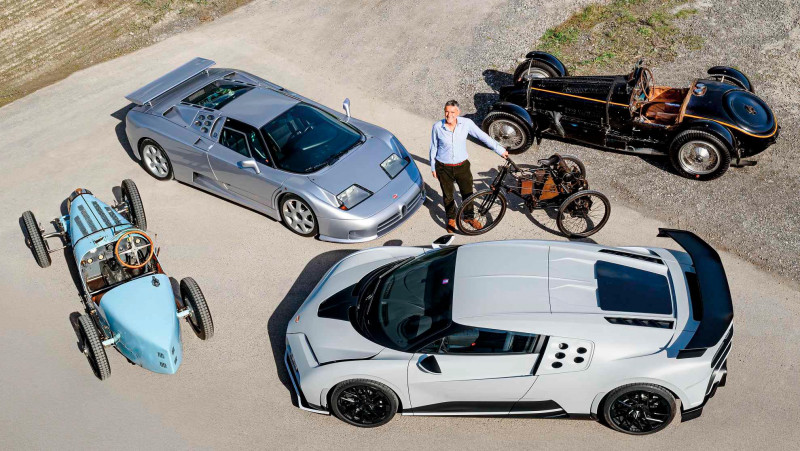
You can’t celebrate 110 years of Bugatti without reference to where it all began. And in this case, the story goes back even further. The Type 1 tricycle of 1899 was Ettore’s first design but it was made by Prinetti & Stucchi, an Italian maker of sewing machines, bicycles and motorised vehicles, so it came before Bugatti was a marque. Perhaps the term ‘running on fumes’ originated here, as the Type 1 has no carburettors but relies for ignition on petrol fumes, which are expedited by the exhaust as it heats the fuel tank! Its engine features four separate cylinders and the 17-year-old Ettore won a 90km race on this example in 1899, beating Gianni Agnelli among others. He enjoyed much success with this, but the Type 2 that followed would be a four-wheeler.
‘With these cars in the back catalogue, it’s easy to understand why there has been more than one attempt at a comeback’
The supercharged Type 35B needs little introduction, being one of the most successful and perfectly formed Grand Prix cars of all time, one of such engineering elegance that any part of it is worthy of a place in an art gallery. In fact, this one featured in Norman Foster’s Bilbao exhibition ‘Motion. Autos, Art, Architecture’ in 2022. It also won the 1929 French Grand Prix, driven by William Grover-Williams.
The Type 59 was the last Bugatti Grand Prix car and is another engineering masterpiece. Its 3.3-litre straight-eight engine gave an impressive 250bhp and its signature, lightweight ‘piano wire’ wheels were a clever way of managing cornering loads with little weight. René Dreyfus won the 1934 Belgian GP in this perfectly preserved example, but Robert Benoist, Jean- Pierre Wimille and King Leopold of Belgium all piloted it at some point; the paintwork dates from King Leopold’s time.
These pre-war Bugattis define the marque and each exhibits Ettore’s obsession with excellence. And with these cars in the back catalogue, it’s easy to understand why there has been more than one attempt at a comeback. The owner of the vehicles here found his passion in a slightly unconventional way. He bought a Chiron and was so stunned by the car that he wanted to know more about the marque.
His hunger to understand Bugatti in turn led to a deep fascination, to a degree that he bought the best available example of each model. It has become a family affair, with his six daughters equally enthusiastic.
‘History and people matter,’ he says. ‘Ettore’s father was a furniture designer, his brother Rembrandt was a sculptor. The artistic influence and legacy are clear to see.
There are many fine automotive designs but Bugatti’s design ethos persists under the skin perhaps more than with any other car maker. It was true in the 1930s and it’s true today.’
The owner appreciates art, is a sportsman and a keen motorist and racer. He strongly believes that a passion for cars, whenever it emerges, ‘has a connection to a childhood experience’. One of his greatest motivations is to involve young people in old cars because, having heard, smelt and experienced them, they will become their future custodians.
He even has a Bugatti pasta machine. When Ettore Bugatti’s chef reported that his pasta maker had broken, Bugatti took matters into his own hands. He had a pasta machine designed and attached a Type 46 steering to operate the compressor. Voilà, pasta in many shapes made reliably with a Bugatti. Every home should have one.
Clockwise, from top right Ex-King Leopold Type 59; the owner with Bugatti-designed
1899 Prinetti & Stucchi Type 1 tricycle; Centodieci; ex-Grover-Williams Type 35B; EB110.


